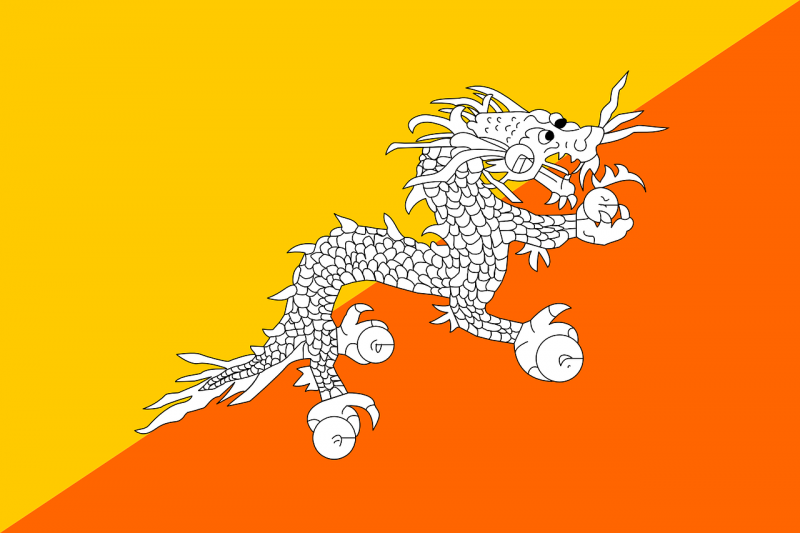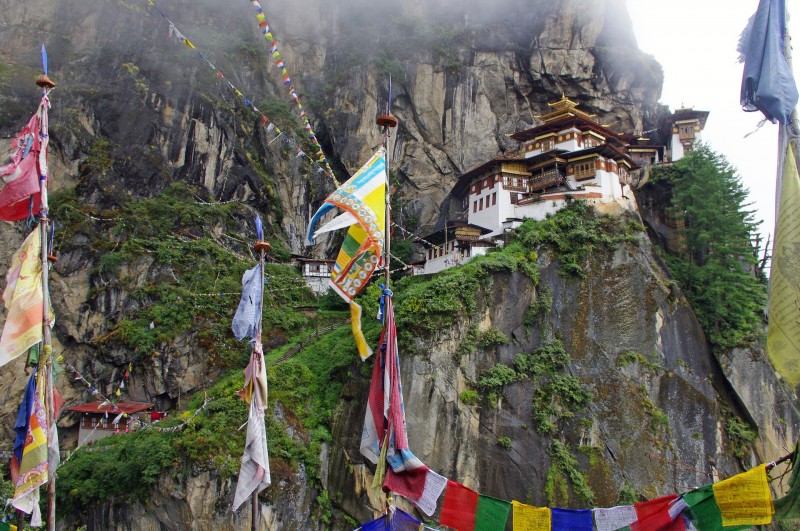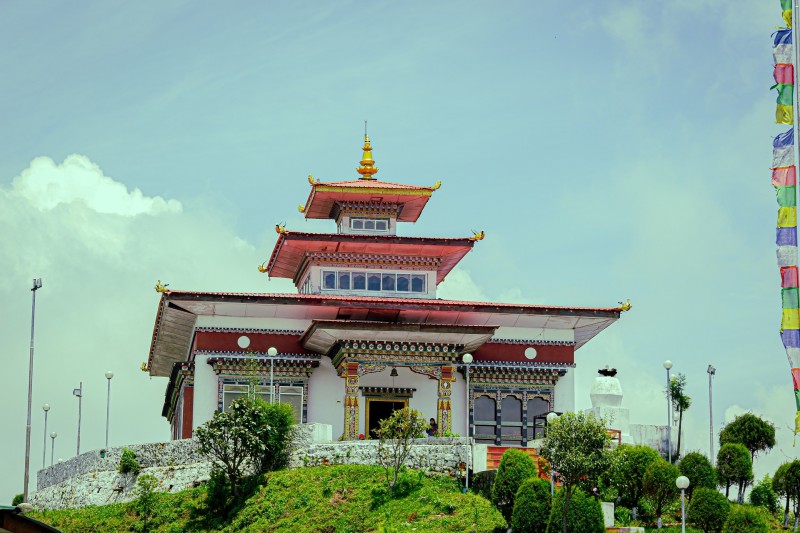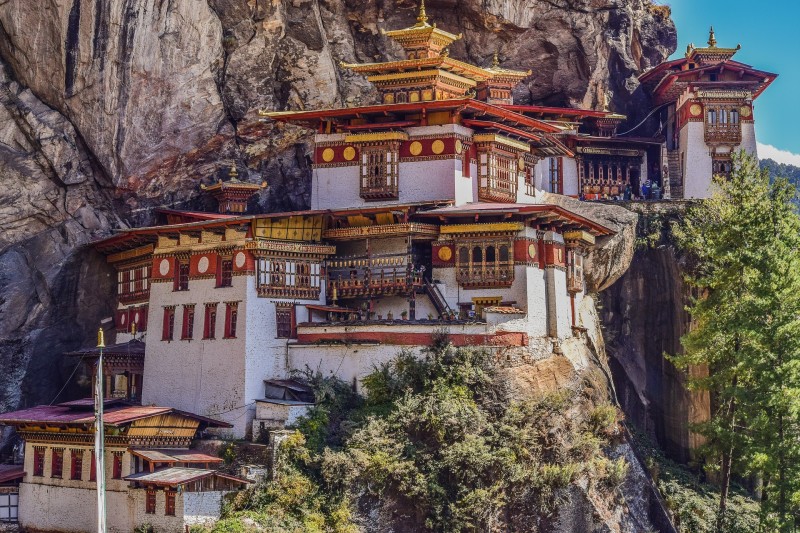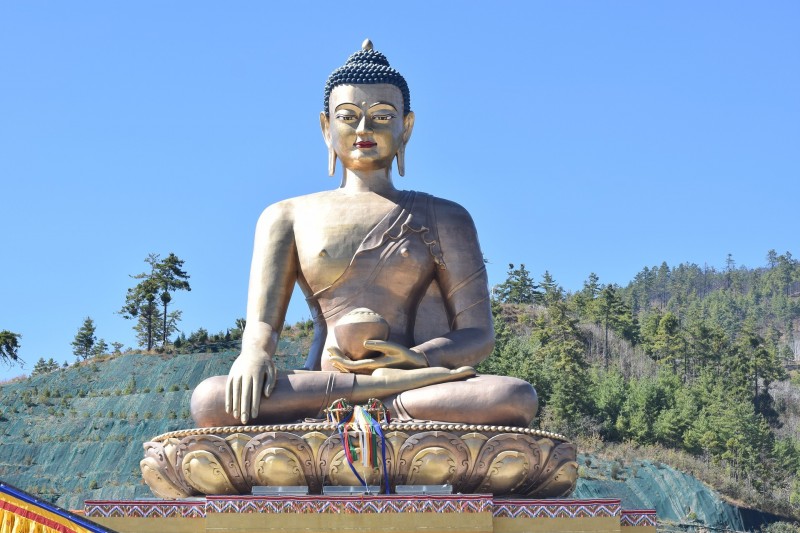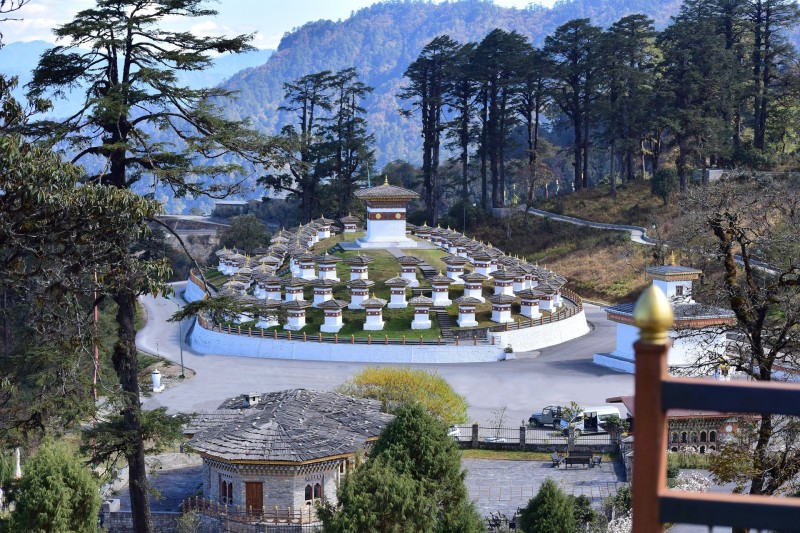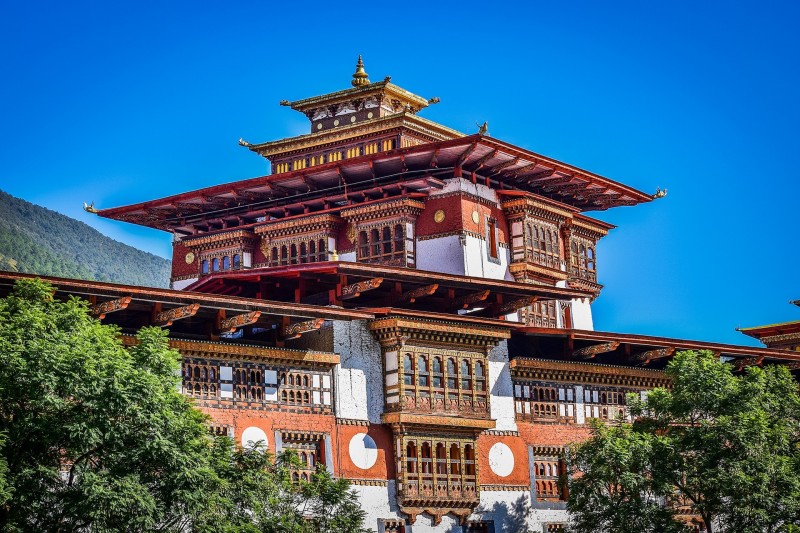Bhutan
Capital city description
Thimphu is the capital and largest city of Bhutan. It is situated in the western central part of Bhutan, and the surrounding valley is one of Bhutan's dzongkhags, the Thimphu District. The city became the capital of Bhutan in 1961. As of 2005, it had a population of 79,185, with 98,676 people living in the entire Thimphu district.
The city is spread out laterally north-south on the west bank of the valley formed by the Raidāk River, known as the Wang Chuu or Thimphu Chuu in Bhutan. Thimphu is spread over an altitudinal range between 2,248 meters (7,375 ft) and 2,648 meters (8,688 ft). Unusually for a capital city, Thimphu is not served by an airport but relies on the Paro Airport connected by road some 54 kilometers (34 mi) away.
As Bhutan's political and economic center, Thimphu has a dominant agricultural and livestock base, contributing to 45% of the country's GNP. Though a contributor to the economy, tourism is strictly regulated, maintaining a balance between traditional, development, and modernization. Thimphu contains most of the important political buildings in Bhutan, including the National Assembly of the newly formed parliamentary democracy and Dechencholing Palace, the King's official residence, located to the city's north. As a metropolis and capital city, Thimphu is coordinated by the "Thimphu Structure Plan," an Urban Development Plan which evolved in 1998 to protect the fragile ecology of the valley. This development is ongoing with financial assistance from the World Bank and Asian Development Bank.
Climate
Southern Bhutan has a hot and humid subtropical climate that is relatively unchanging throughout the year. Temperatures can vary between 15-30 degrees Celsius (59- 86 degrees Fahrenheit). In the Central parts of the country, which consists of temperate and deciduous forests, the climate is more seasonal, with warm summers and cool and dry winters. In the far Northern reaches of the kingdom, the weather is cooler during winter. Mountain peaks are perpetually covered in snow, and lower parts are still cool in summer owing to the high-altitude terrain.
Languages spoken
The official and national language of Bhutan is Dzongkha. It is spoken mainly in the western part of the country. Sharchopkha is a primary regional language spoken in eastern Bhutan, while in the Bumthang region, Bumthangkhan is spoken. In urban areas, especially in tourist centers, English and Hindu are understood by most people. Some people who have roots in Nepal speak Nepali in the southern region. The other languages spoken in some parts of the country include Assamese, Limbu, Santali, Sherpa, Gurung, Western Gurung, and Eastern Magu.
Fun/Fascinating Facts
- Bhutan is about half the size of South Carolina. The country is slightly smaller than Switzerland. It is only around 14,800 square miles (38,400 square kilometers) of territory.
- Bhutan has an obligatory national dress code. Men wear traditional, knee-length garments, and women must wear ankle-length dresses. The colors give away someone's social class and status.
- If you are found guilty of killing a highly endangered and culturally sacred black-necked crane in Bhutan, you could be sentenced to life in prison.
- Bhutanese are forbidden to marry foreigners. Homosexuality is also prohibited by law. Polygamy is legal in Bhutan. However, the practice is uncommon.
- Inheritance like land, house, and animals is generally passed to the eldest daughter rather than the eldest son.
Unique Customs/Traditions
- People in Bhutan fly tiny white flags on their rooftops to indicate that they’ve appeased the local gods. They have their meals seated cross-legged on wooden floors, serving the head of the family first. A crumb of food is left as an offering for spirits before consuming the meal.
- In Bhutan, if people offer you food, you have to say “Meshu” and close your mouth to express a sense of gratitude and unwillingness to the inconvenience of others. However, if people keep offering you, it’s polite to accept the offers.
- Rituals are practiced with enthusiasm and reverence. Religious places and monuments, stupas, and prayer flags are highly significant. When passing by places of worship, people make sure that their right side is nearest to the structure as a mark of respect. They spin their prayer wheels in a clockwise direction.
- Footwear is left outside religious sites and temples. All art in the country is based on religious themes, is anonymous, and does not have any specific aesthetic purpose.
Popular universities
| Name | Description | |
|---|---|---|
| The Royal University of Bhutan (RUB) | The Royal University of Bhutan (RUB) is the only national University present in the country. It was founded on June 2nd, 2003. The University was established to provide the needs of Tertiary Education in Bhutan and offer various Higher Education Programs to aspiring students. RUB (The Royal University of Bhutan) aspires to build a knowledge-based society that can influence public policy and social behavior and teach empirical research and informed opinions in Bhutan. | |
| Royal Thimphu College | Royal Thimphu College was established in 2009. A private university located in P.O.Box # 1122, Ngabiphu, Thimphu, Bhutan. Thimphu is the capital and largest city of Bhutan. Royal Thimphu College is an officially registered university with the Ministry of Education, Royal Government in Bhutan. | |
| Khesar Gyalpo University of Medical Sciences of Bhutan | Khesar Gyalpo University of Medical Sciences of Bhutan is the first medical University in Bhutan. The Khesar Gyalpo University of Medical Sciences of Bhutan was established in 2013 as per the University of Medical Sciences Act of Bhutan 2012. The University was renamed the Khesar Gyalpo University of Medical Sciences of Bhutan by Her Gyaltsun, The Queen of Bhutan, on 29th March 2015, thereby befitting our King's effort toward their selfless service to nation-building. His Majesty the King is the Chancellor of the University and is governed by the Governing Council with Hon'ble Prime Minister as the Chairperson. It has an Advisory Board with members from Bhutan and prominent professors from regional and international universities. It consists of the Faculty of Nursing and Public Health, Faculty of Traditional Medicine, Faculty of Postgraduate Medicine, Medical Education Centre for Research, Innovation and Training (MECRIT), and the Office of President. | |
Festivals & Events
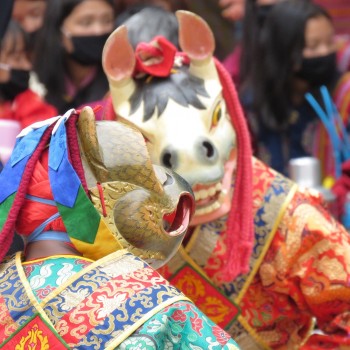
The black-necked Crane Festival
Date: November 11
The black-necked Crane Festival is celebrated yearly in the Phobjikha valley on 11th November. Every winter, the cranes migrate south to the valley from Tibet and fly back in early spring. In pursuit of Bhutan’s commitment to conserve and strengthen the ecological system, the winter habitat for these endangered birds has been identified and protected.
The festival celebrates the arrival of the majestic birds to their valley. The committee organizing the festival constitutes many locals who are committed to growing and preserving this tradition. The festival aims to raise awareness and encourage locals to conserve the environment for these endangered species and offer economic incentives. The festival generally includes a cultural program such as folk songs, a masked dance performed by locals, students, and monks in the community.
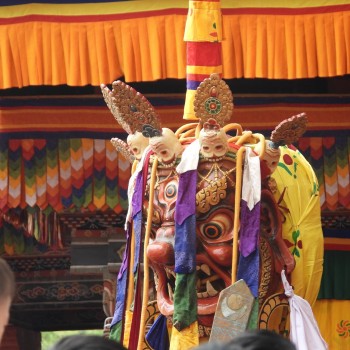
Chorten Kora Festival
Date: April
The Chorten Kora festival is held in Trashiyangtse, in the east of the county. It is known as Dakpa Kora. The Chorten Kora Festival is one of the oldest religious festivals, which takes place yearly at Chorten Kora, an important stupa next to the Kulong Chu River in the region.
The festival is dedicated to a young lady from Tawang who agreed to be buried inside the Chorten alive. During this festival, the Chorten Kora is seen to remain crowded by the pilgrims.
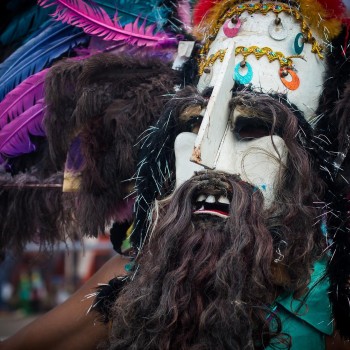
Thimphu Tshechu
Date: September
Thimphu Tshechu is one of the biggest festivals in Bhutan. This festival is held in the capital city, in the courtyard of the Tashichhodzong, for three days beginning on the 10th day of the 8th month of the lunar calendar.
Thousands of people witness the Thimphu Tshechu festival from neighboring Dzongkhags (districts) to attend the festivities. The actual Tshechu is preceded by days and nights of prayer and rituals to invoke the gods.
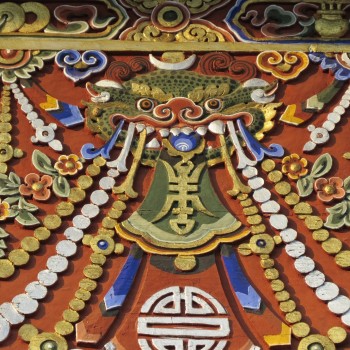
Haa Summer Festival
Date: July
The Haa Summer Festival, a lively festival, is held yearly in July, showcasing the people's nomadic lifestyle in Bhutan and honoring their religion, traditional songs, dances, and music.
It provides exceptional insight into the lives and traditions of Bhutan's nomadic herders. It demonstrates a lively traditional living culture, nomadic lifestyles, and exhibit of local cuisines, brewing of local ara, traditional sports, religious performances, dances, songs, artifacts, and natural alpine flowers.
Attractions / Top Sights
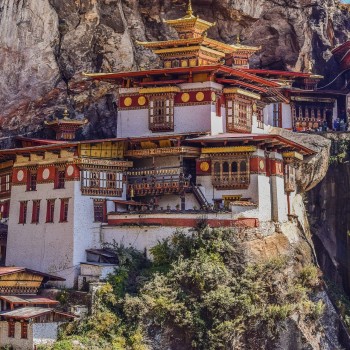
Taktsang Monastery
When to visit: March to May and September to mid-November
When to visit: https://www.travelogyindia.com/blog/top-10-tourist-attractions-in-bhutan/
Taktsang Monastery is renowned for its view, location, and meditation. Located on the top of a high cliff made of granite, this is one of the holiest places in the country. It is also called the Tiger's Nest of Paro. The monastery is perched on the edge of the hill, and you can see the Paro valley and the river from the monastery.
The monastery has been said to exist since the 8th century. Guru Padma Sambhava, a religious leader, meditated in this spot, which later became this monastery's spot. This monastery is excellent among those who love to enjoy meditation, exploration, natural sightseeing, trekking, and much more.
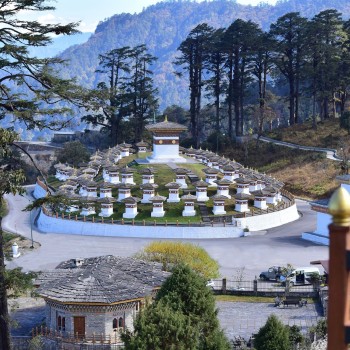
Thimphu
When to visit: March to May and September to mid-November
When to visit: https://wikitravel.org/en/Thimphu
Thimphu (ཐིམ་ཕུག།) is the capital of the Kingdom of Bhutan, and with a population of around 80,000, is the nation's largest city of Bhutan. It is located on the laps of the Himalayas. The view from this place is fantastic. It is the only city in the world to have zero traffic lights. The town has maintained to keep its link with the culture and tradition of the land
Currently, the town is undergoing massive development. New tree-lined streets are being laid, and the clock tower area in the center of the city has been transformed into a park-cum-open air theater where live cultural performances occur. In 2008, the national stadium was completed together with a new river-side park. The area around the dzong and government buildings is an exceptionally green and attractive district.
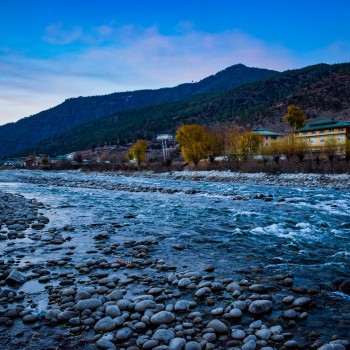
Paro
When to visit: June until November
When to visit: https://www.drukair.com.sg/destinations/paro/
Paro is one of Bhutan’s most historic valleys of Bhutan. Surrounded by valleys, mountains, and rice fields, this region is an important historical site. Traditional architecture is shown along Paro’s main street, featuring richly decorated buildings that house small shops, institutions, and restaurants.
Important cultural sites can also be found in the district of Paro, including Taktsang, or Tiger’s Nest, the most famous monastery in Bhutan. Kyichu Lhakhang, one of the country’s oldest temples, dating back to the 7th century; Rinpung Dzong, also known as Paro Dzong, a massive monastery and fortress where scenes from the Little Buddha movie was filmed; and many others.
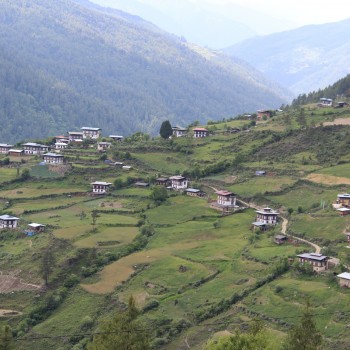
Phuentsholing
When to visit: February to April and October to December
When to visit: https://www.travelogyindia.com/blog/top-10-tourist-attractions-in-bhutan/
Phuentsholing is a small town in Bhutan, which is well-known for its serene nature and solitude environment. You can find a few attractions here like the crocodile breeding spot, hydrothermal project, Bhutan Gate, Karbandi monastery, etc.
Phuentsholing is the point of entry for travelers arriving by bus from Kolkata and Siliguri, and the town functions primarily as a place where Bhutanese and Indians do business.
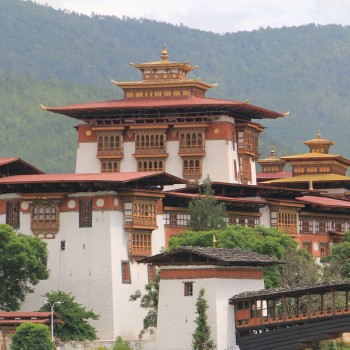
Wangdue Phodrang
When to visit: February to April and October to December
Wangdue Phodrang is located close to the central highway, a famous destination in Bhutan. This valley is rich in pasture and cattle. The place is renowned for bamboo souvenirs, stone carvings, slate carvings, and others.
The significant attraction of this region is the Tang Chhu and Panakha Chhu. These two rivers add more beauty to the land. Visit the Wangdue Phodrang Dzong, located on the top of the hill, where both the rivers start.
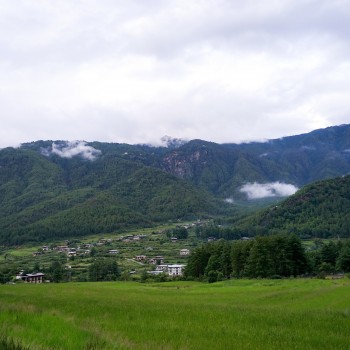
Bumthang Valley
When to visit: March to May
When to visit: https://beatbhutan.com/bumthang-valley/
Bumthang Valley, known as “The Spiritual Heartland of Bhutan,” is consists of four beautiful glacial valleys of Ura, Chumey, Tang, and Choekhor valley. It has countless numbers of ancient temples and monasteries for the pilgrimage for the locals. Because of the visits made in the land by some of the highly revered Buddhist saints, it is called the spiritual heartland of Bhutan.
It has broad and scenic valleys, and it is one of the most beautiful valleys in the country, and it holds some of the country’s most popular and sacred mask dance festivals in these beautiful and charming valleys.
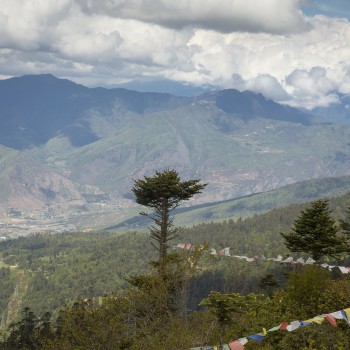
Gangtey and Phobjikha
When to visit: October to December
When to visit: https://traveltobhutan.travel/places-to-visit-in-bhutan/gangtey/
Gangtey and Phobjikha fall under the district of Wangdue Phodrang. These two valleys are famous for their glaciers and the stream flowing to the open grasslands. These valleys lie on the periphery of the Black Mountain National Park.
The valley flaunts two beautiful meandering rivers, Nakay Chu (black water) and Gay Chu (white water). These two valleys are highly recommended places to visit in Bhutan.















